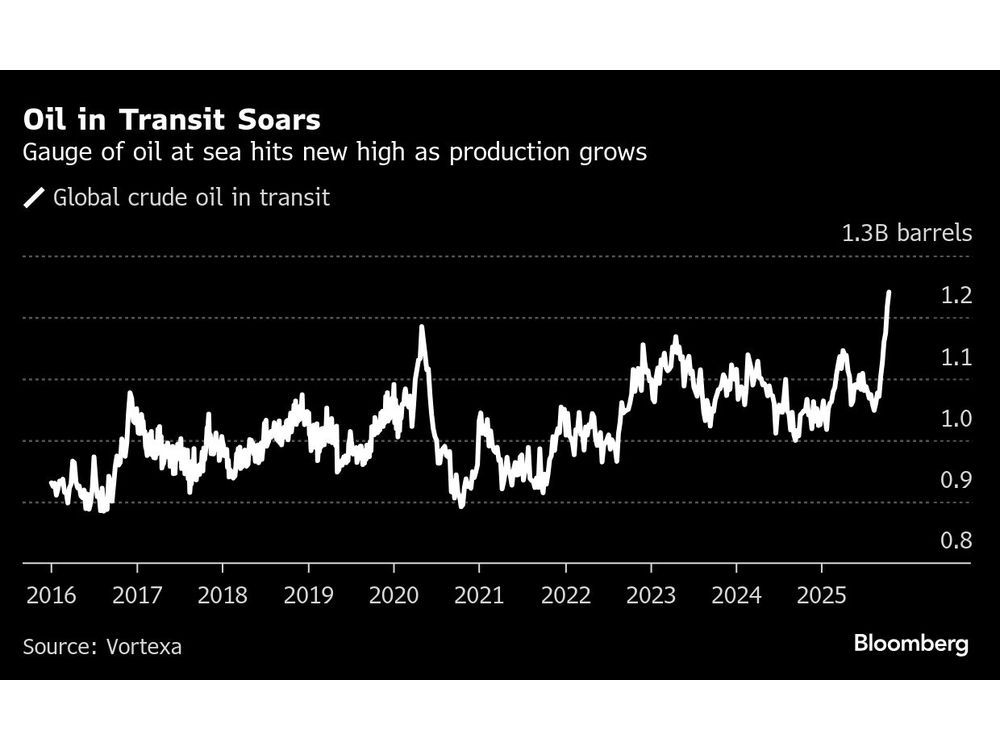Business
Global Crude Oil Transport Hits New High Amid Production Surge

The volume of crude oil transported across the world’s oceans has reached unprecedented levels, fueled by increasing production and longer shipping distances. In the week leading up to October 17, 2023, a total of 1.24 billion barrels of crude and condensate were being transported on tankers, according to data from analytics firm Vortexa. This figure marks an increase from a revised 1.22 billion barrels the previous week and does not include oil in floating storage, which is defined as oil on vessels that have been stationary for at least seven days.
The surge in oil transport is largely attributed to members of the OPEC+ coalition, which includes several oil-producing nations that are gradually unwinding previous output cuts. Specifically, countries outside OPEC+, particularly in the Americas, are ramping up production. Notably, Guyana has recently commenced extraction from a new offshore field, while U.S. output has reached a record high.
As global supply increases, demand growth is beginning to slow. Analysts forecast that a surplus could rise to as much as 4 million barrels per day in the early months of 2024. This anticipated surplus comes despite the OPEC+ group raising its collective production target by almost 2.5 million barrels per day between March and September 2023.
Production Increases from Key Players
While actual production has not fully aligned with the target increases, OPEC+ has still added over 2 million barrels per day to its supply during this period. The most significant contributions have come from Saudi Arabia, the United Arab Emirates, and Russia, whose combined output has risen by 1.77 million barrels per day. Most of this crude is being shipped to major buyers in Asia, especially China, with voyages from the Middle East taking approximately a month and often twice that time from Russia.
In September, OPEC+ production experienced a notable increase of 630,000 barrels per day, marking the largest month-on-month addition in four years, according to secondary data published by OPEC.
Emerging Markets and Long-Distance Shipping
In addition to OPEC+ developments, Guyana has made strides in its oil production. The country dispatched its first cargo of the new Golden Arrowhead grade at the end of August, with production expected to plateau at 250,000 barrels per day. Concurrently, U.S. oil output is reported to have surpassed 13.63 million barrels per day, the highest recorded in recent data from the Energy Information Administration.
The increase in production has led to longer shipping times, contributing to the growing amount of oil in transit. A supertanker carrying Guyanese crude is currently en route to China, marking the first shipment to the country since May. This voyage is projected to take over six-and-a-half weeks, significantly longer than the trip to Rotterdam, which is Guyana’s largest European destination. Additionally, two Indian refiners have secured shipments of Guyana’s crude, the first since tracking began in November 2021.
The current dynamics of oil production and transportation underscore the complexities of the global energy market, as supply and demand continue to evolve.
-

 Lifestyle2 months ago
Lifestyle2 months agoWinnipeg Celebrates Culinary Creativity During Le Burger Week 2025
-

 Health2 months ago
Health2 months agoMontreal’s Groupe Marcelle Leads Canadian Cosmetic Industry Growth
-

 Science2 months ago
Science2 months agoMicrosoft Confirms U.S. Law Overrules Canadian Data Sovereignty
-

 Education2 months ago
Education2 months agoRed River College Launches New Programs to Address Industry Needs
-

 Technology2 months ago
Technology2 months agoDragon Ball: Sparking! Zero Launching on Switch and Switch 2 This November
-

 Science2 months ago
Science2 months agoTech Innovator Amandipp Singh Transforms Hiring for Disabled
-

 Technology2 weeks ago
Technology2 weeks agoDiscord Faces Serious Security Breach Affecting Millions
-

 Technology2 months ago
Technology2 months agoGoogle Pixel 10 Pro Fold Specs Unveiled Ahead of Launch
-

 Science2 months ago
Science2 months agoChina’s Wukong Spacesuit Sets New Standard for AI in Space
-

 Technology2 months ago
Technology2 months agoWorld of Warcraft Players Buzz Over 19-Quest Bee Challenge
-

 Education2 months ago
Education2 months agoAlberta Teachers’ Strike: Potential Impacts on Students and Families
-

 Business2 months ago
Business2 months agoDawson City Residents Rally Around Buy Canadian Movement
-

 Technology2 weeks ago
Technology2 weeks agoHuawei MatePad 12X Redefines Tablet Experience for Professionals
-

 Business2 months ago
Business2 months agoNew Estimates Reveal ChatGPT-5 Energy Use Could Soar
-

 Science2 months ago
Science2 months agoXi Labs Innovates with New AI Operating System Set for 2025 Launch
-

 Technology2 months ago
Technology2 months agoInnovative 140W GaN Travel Adapter Combines Power and Convenience
-

 Technology2 months ago
Technology2 months agoFuture Entertainment Launches DDoD with Gameplay Trailer Showcase
-

 Education1 month ago
Education1 month agoBrandon University’s Failed $5 Million Project Sparks Oversight Review
-

 Technology2 months ago
Technology2 months agoGlobal Launch of Ragnarok M: Classic Set for September 3, 2025
-

 Business2 months ago
Business2 months agoBNA Brewing to Open New Bowling Alley in Downtown Penticton
-

 Technology2 months ago
Technology2 months agoNew IDR01 Smart Ring Offers Advanced Sports Tracking for $169
-

 Technology2 months ago
Technology2 months agoArsanesia Unveils Smith’s Chronicles with Steam Page and Trailer
-

 Science2 months ago
Science2 months agoNew Precision Approach to Treating Depression Tailors Care to Patients
-

 Technology2 months ago
Technology2 months agoHumanoid Robots Compete in Hilarious Debut Games in Beijing










